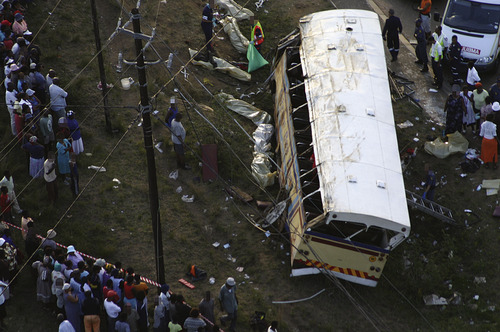CASE 40
Incident
Patients are being extricated by passers-by and voluntary Emergency Services personnel and moved to a nurse-led clinic nearby. You are being sent to the clinic.
Relevant information
▪ Aircraft: Fixed wing. Two stretcher and one seated capacity
▪ Local resources: One land ambulance: Police and voluntary Fire & Rescue Services including experienced remote-clinic nurse
▪ Retrieval options: Major trauma hospital 1.5 hours by air (additional short road transfer from the airport) or 6 hours by road
▪ Other: Nil
Questions
40.1 What should you do before you leave?
40.2 What is your initial pre-hospital plan?
 |
As you arrive, you fly over the now largely evacuated scene (above).
No additional information is received from the clinic prior to your arrival and you are able to land safety on a tarmac road nearby. When you arrive, you find the following:
40.3 Describe the scene you have just flown over.
40.4 Describe your immediate actions on arrival at the clinic and thereafter.
Discussion
40.1 The key here is to consider what is available to you prior to departure. Additional PHR team(s) and equipment may be assembled or immediately available. Taking appropriately packaged O-negative blood would also be highly desirable in this instance. Discuss with the pilot how many patients can be carried and whether things should/could be left at base (e.g. seats, irrelevant equipment etc.) to reduce weight. If there are mission ready ‘major incident’ bags, make sure that you have them on board.
Travelling such a distance allows adequate time for planning and this should not be wasted. Plan to keep in touch with the tasking agency/coordinator for updates on numbers, ages and clinical condition of casualties. Discuss with them what potential local resources are available. How many nurses and paramedics are there? Where is the next nearest healthcare facility? Are additional regional air medical resources available? In essence, this is a primary tasking as patients are likely to have had little input into their care either before or in the clinic. You should discuss frankly the possibility of this becoming a major incident so the coordinator can look into extraordinary resource utilisation (e.g. military assistance). Finally, use the time en route to prepare by drawing up and labelling appropriate drugs, pre-priming fluid infusion lines and developing a pre-hospital plan with your team members.
< div class='tao-gold-member'>
Only gold members can continue reading. Log In or Register to continue
Stay updated, free articles. Join our Telegram channel

Full access? Get Clinical Tree








